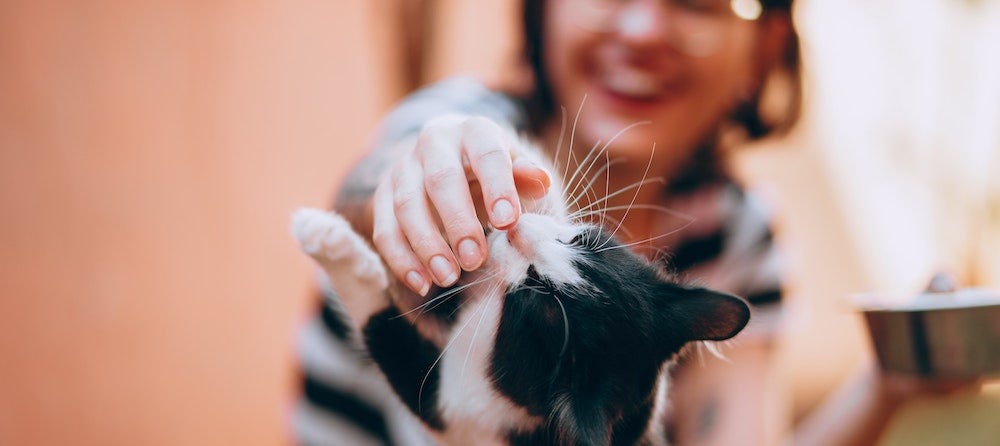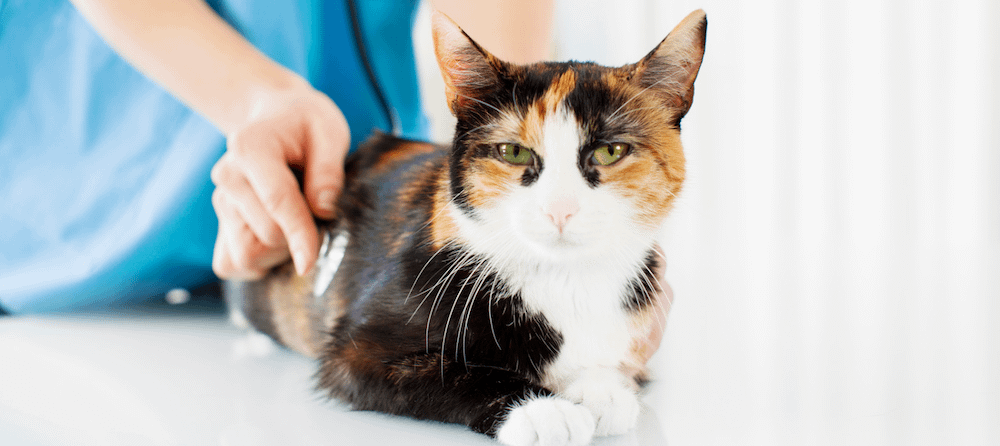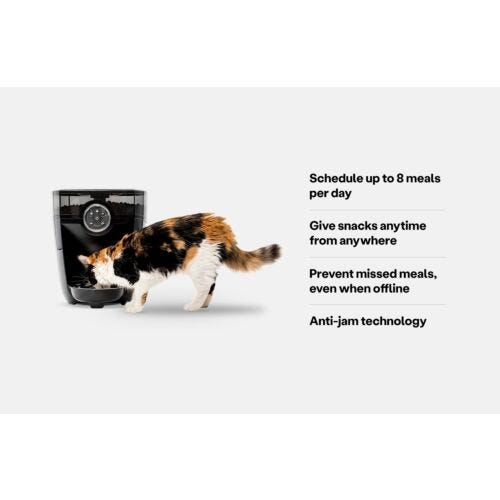Whether you’re thinking about adopting a cat for the first time or your resident kitty is open to a friend, there’s a lot to consider. We’re here to help.
"Adopt don’t shop" is a trending phase in the animal advocacy community, and for good reason. According to the American Society for the Prevention of Cruelty to Animals (ASPCA), 3.1 million cats and kittens enter the shelter system each year. And this number doesn’t account for the 30 to 40 million community cats that live on their own. Of the adoptable cats and kittens that enter the shelters annually, 2.1 million find loving homes each year—leaving another million in need of a home like yours.
Adopting a cat or kitten is good for everyone—you’ll be giving a cat a loving home and gaining a fur-ever feline friend. No matter where you are in your adoption journey, we’ve laid out the questions to ask yourself, resources and organizations to turn to, and other options for helping animals in need when you’re not ready to adopt.
How to adopt a cat – 8 essential steps
Whether you adopt a cat from a shelter, a breeder, or elsewhere, the process requires careful consideration at every step.
- Research: Take time to research different cat breeds, personalities, and care requirements to find a cat that matches your lifestyle and preferences. Consider factors such as size, energy level, grooming needs, and temperament.
- Choose adoption source: Decide whether you want to adopt from a local animal shelter, rescue organization, or through private adoption. Each option has its own benefits, but all provide loving cats in need of homes. Whatever you choose, spend time interacting with the cats to get a sense of their personalities and find a good match for you.
- Ensure you know what to expect: Before saying the final "I do," get to know the cat and ask questions about their behavior, medical history, and any special needs they may have.
- Complete an adoption application: Many shelters and rescue organizations require prospective adopters to fill out an adoption application. This application typically asks questions about your living situation, previous experience with pets, and your plans for caring for the cat. Some organizations may require a home visit to ensure that your living environment is suitable for a cat. This is usually a quick and informal visit to ensure that you have a safe and cat-friendly home.
- Pay adoption fee: There is usually an adoption fee associated with adopting a cat from a shelter or rescue organization. This fee helps cover the cost of caring for the cat while in the organization's care and may include vaccinations, spaying/neutering, and microchipping.
- Prepare your home: Before bringing your new cat home, make sure you have all the necessary supplies, including food and water bowls, a litter box, scratching posts, toys, and a cozy bed. Set up a designated area for your cat to explore and acclimate to their new surroundings.
- Bring your cat home: Once everything is prepared, it's time to bring your new cat home! Make sure to introduce them to their new environment slowly and provide plenty of love, attention, and patience as they adjust to their new home.
- Schedule veterinary appointment: Schedule a veterinary check-up for your new cat soon after bringing them home. This is important to ensure they are healthy and up-to-date on vaccinations, and it gives you an opportunity to discuss any questions or concerns with your veterinarian.
In this article, we will discuss these items more in-depth and guide you toward the right options.
1. Should you adopt a cat? Questions to ask yourself
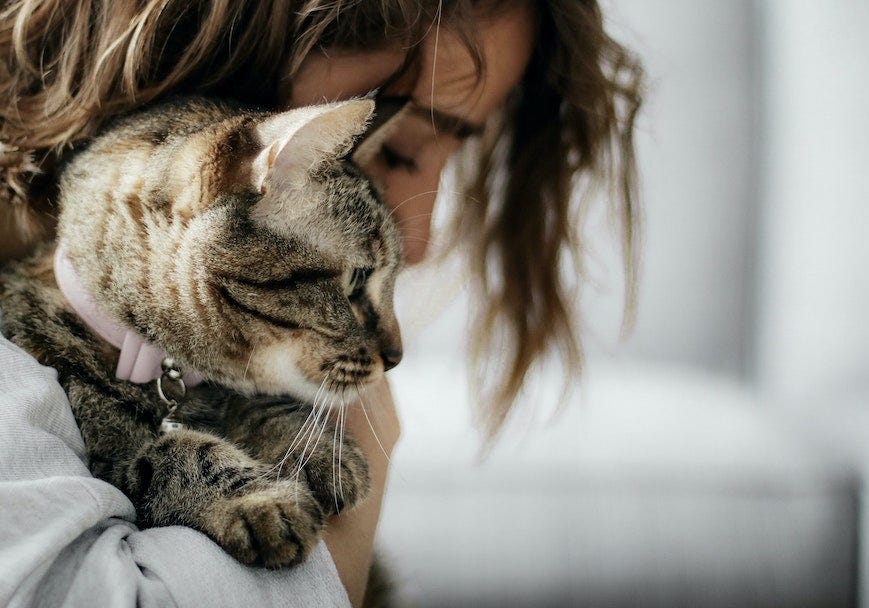
Shannen McNee, CCBC at The Toronto Humane Society, says to consider the big picture of adopting any pet: lifestyle, the longevity of the decision, budget, and environment. If you or another member of your household is considering adopting a cat or kitten, ask these questions first:
Am I prepared for a long-term commitment?
Depending on the age of the cat you adopt, they could be your trusty companion for 20+ years. This is great news for us pet parents, but an important consideration for prospective parents.
Can I afford to take care of a cat?
The cost of a cat or kitten is more than the upfront adoption fee. Your new cat will need supplies like a litter box, food, toys, and enriching furniture—not to mention routine check-ups and unexpected medical costs. According to the 2021 – 2022 APPA Survey, the average cat household spends $801 on veterinary care a year.
Is my house or apartment cat-friendly?
If your landlord doesn’t allow pets, then adopting a cat is a no-go. What areas of the house will your cat have access to and are they suitable for exercise and enrichment?
Do my career, social life, and other lifestyle choices support caring for a cat?
Will you be able to spend quality time with your new cat and provide care when you’re away?
Will my pets get along?
If you already have a cat or a dog, you should think about their temperament first. Will they get along with another pet? Will they enjoy the company?
If your cat looks lonely, getting another pet may seem like a good idea, but not all temperaments are compatible. Some pets naturally get along well with others, while others may require more time and effort to adjust to a new companion.
Should I adopt a kitten or an adult cat?
“Kittens require more initial training and a longer commitment than adult cats,” McNee says. “Adult cats may be a better bet if you’re looking for a certain temperament, and nothing is more rewarding than providing a home for a senior cat. Just keep in mind senior cats are more likely to develop health issues sooner than a younger cat might.”
Should I adopt more than one cat?
If a pair of adult cats are bonded, keeping them together can reduce stress and improve their quality of life. Other adult cats may prefer to have a home all to themselves. When it comes to kittens, some shelters and rescues require the adoption of two kittens for healthy socialization. Remember, says McNee, “double the cats can also be double the cost.”
2. What kind of cat should you adopt, and where to adopt a cat
Purebred cats

Purebred cats are often very beautiful. Adopting a purebred cat might be more straightforward if you are looking for a certain aesthetic, as they often have predictable appearances and behaviors. Certain cat breeds can also be friendlier than others. Before adopting a purebred cat, don’t skip researching the breed of interest and preparing for any medical conditions the breed is prone to.
Whether you are into long-haired cat breeds, miniature cats, or even hairless breeds, finding the right breeder is the way to go. Ensure they are reputable, prioritize the health and well-being of the cats, and provide proper documentation.
Adoption isn’t entirely out of the question. Purebred cats can be found in the shelter system from time to time, but you’ll likely have better luck by seeking out rescue organizations dedicated to rare and purebred cats. Some trusted purebred rescues include:
- Specialty Purebred Cat Rescue
- Saving Fancy Cats
- Purebred Plus Cat Rescue
- Bengal Rescue
- Seattle Persian and Himalayan Rescue
- Siamese Cat Rescue
“There are a lot of cats, though, that resemble a particular breed, and you’ll find them in shelters and rescues,” Bays adds. “Cats with Siamese type coloring, grey cats the color of a Russian Blue, and larger Maine Coon type cats are commonly found in shelters and rescues.”
Because of their breed status, purebred cats can be more expensive. For popular and widely available breeds like the Siamese, Maine Coon, or Persian, you might find kittens priced between $500 to $1500 on average—but this can go upwards of $5,000 for cats with exceptional pedigrees and rare cat breeds.
Purebred cats may also have higher healthcare costs, as selective breeding has caused many breeds of cats to develop genetic health problems.
Shelter rescue
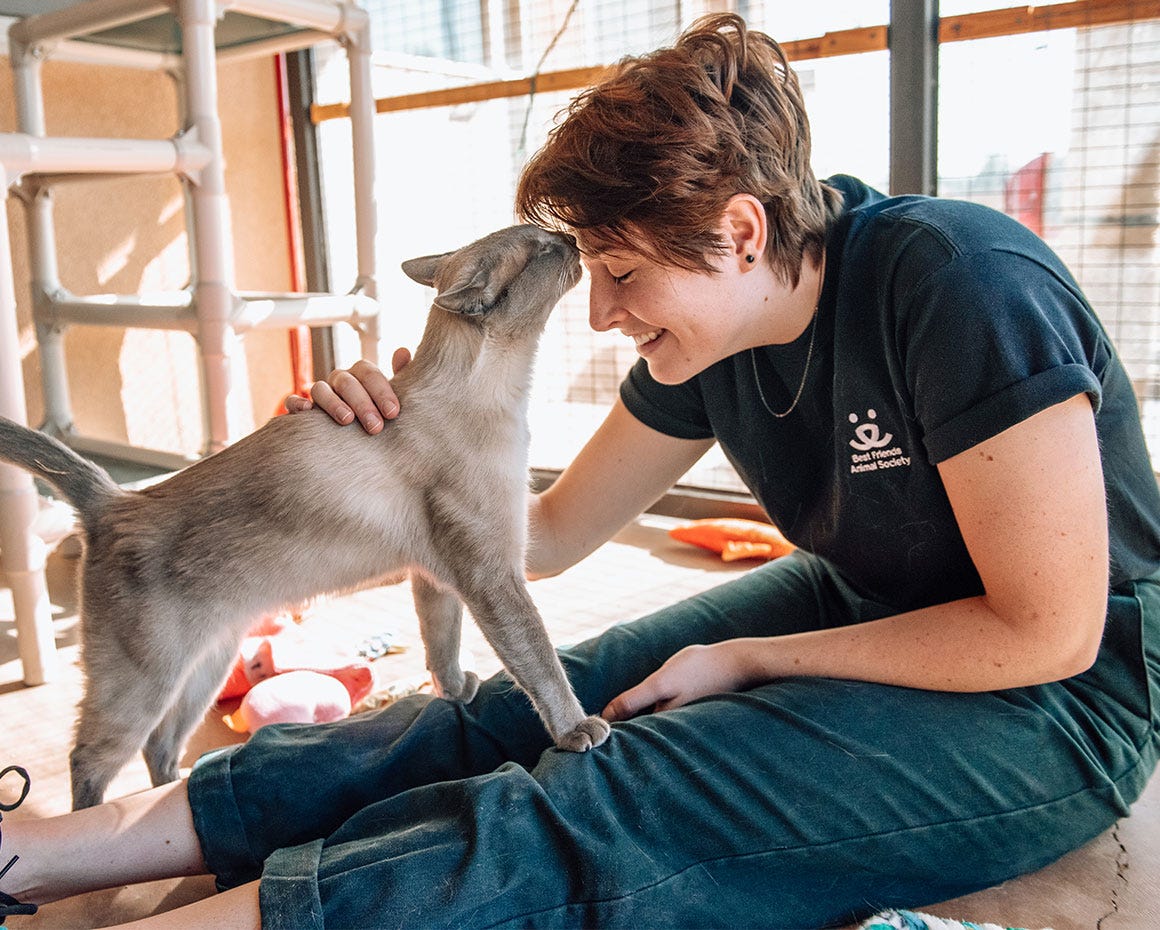
A tried-and-true method of adopting a cat includes checking out your local shelter or rescue organization. “Healthy cats are available for adoption from shelters and rescues across the country and many have a wide selection of cats to choose from,” explains Danielle Bays, senior analyst of cat protection and policy for the Humane Society of the United States. “These cats are usually checked by a veterinarian, vaccinated against typical feline diseases, and spayed or neutered prior to adoption.” As a result, a rescue cat from a shelter will typically be "good to go," and you only have to pay a donation, on average between $50 and $300, to adopt the pet.
“When you adopt from a reputable animal welfare organization, you have the opportunity to go through a complete adoption process, which will help to prepare you for all that pet ownership entails,” McNee explains. Chances are, one of these nationwide organizations serves your geographic location.
Some common cat rescue options include:
- The Humane Society - A global organization, spanning 50 counties. When adopting a cat from the Humane Society, you’ll have peace of mind knowing that your cat is up to date on vaccinations and medical screenings, is spayed or neutered, and microchipped. The Humane Society also offers pet parenting workshops and can connect you with an on-staff behavioralist when you’re in need.
- The ASPCA - The first humane society in America and continues to be one of the largest humane societies to date. The organization takes in millions of animals each year in addition to their on-the-ground work for animals in need. You can find adoptable cats, low-cost spay and neuter programs, and other resources via the ASPCA.
- Online pet adoption websites - In addition to national welfare organizations, online resources like Pet Finder and Adopt A Pet help prospective adopters find pets nearest them.
- Cat cafes - "Cat cafes often team up with rescues or shelters to offer cats for adoption, or they may be run by the adoption organization directly,” Bays explains. “Cat cafes offer adopters a great way to meet cats in homelike settings and find a cat that is a good fit for their lifestyle." They first made an appearance in Taiwan in the late 90s and have since popped up in almost every state across the U.S. While you sip your latte, you can indulge in non-committed cat cuddles or consider your next adoption, all while socializing adoptable cats and giving them a much-appreciated break from the shelter setting.
Many shelters provide adoption counselors to help future pet parents navigate how to choose the best cat for their lifestyle and information on how to care for your new furry family member—an invaluable tool for first-time and multi-pet households. “By adopting from a shelter or rescue, you help save a cat in need, as well as open up space for the organization to help another cat in need,” Bays adds.
Adopting a rescue cat can be incredibly rewarding. Knowing that you're providing a home to a cat in need can be truly fulfilling, especially when rescuing an older cat rather than a kitten. Some people choose to blind cats or cats with a disability.
Ultimately, adopting a cat requires commitment, patience, and a willingness to adapt your home and lifestyle to meet your cat's needs. However, the love and companionship you receive in return can make it all worthwhile.
Adopting a cat from family and friends
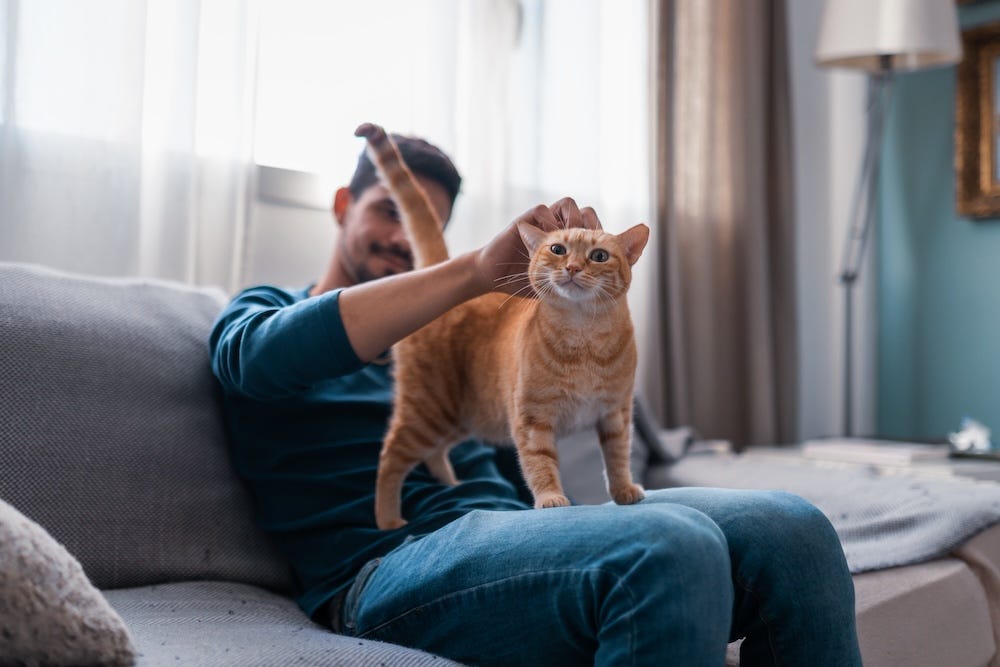
“Sometimes the realities of life prevent someone from keeping a cat or the owner may have passed away, leaving behind a beloved cat. Bypassing a stay at the shelter can be less stressful for cats, who typically don’t like a lot of change,” Bays says. If you choose to adopt outside of an organization, just remember to follow up with all the needed appointments, including spaying and neutering.
Adopting a stray cat

Stray cats are typically cats that have been abandoned or lost and are living without a permanent home.
Adopting a stray cat may be more challenging, as they are likelier to have unknown medical histories and behavioral issues stemming from their time on the streets. It's important to have them checked by a veterinarian and to be patient as they adjust to indoor living. Remember to follow up with all the needed veterinary appointments, including spaying and neutering.
Stray cats may also require additional time and effort to socialize and trust humans, especially if they have had negative experiences in the past.
Additionally, there can be legal implications to taking in a stray cat, so it's important to familiarize yourself with local laws and regulations.
3. Questions to ask the shelter when adopting a cat
Has a cat or kitten caught your eye? McNee says this is the time to ask the shelter key questions:
- What is the annual average cost of owning this animal? What is the adoption fee?
- Is the cat spayed, neutered, and vaccinated?
- Does the cat have any known medical conditions? Ask for a list you can bring to your veterinarian to get a quote on the average cost to manage or treat the conditions.
- What is the temperament of the cat?
- Do you know if this cat does well in a home with children, a lot of visitors, a single person, or other pets?
4. Adoption application

If you are adopting a cat from an animal shelter or rescue organization, you may be required to fill out an adoption application. The purpose of the application is to help these organizations ensure that the cat is going to a suitable and responsible home where they will receive proper care and attention. It also helps you think about the responsibility of owning a pet.
Here's what you can typically expect from an adoption application:
- Personal information - basic personal information about you, including your name, address, phone number, and email address. Some applications may also request information about your occupation and living situation. You typically have to be 18 years old or older to adopt a cat.
- Household information - questions about your household, including the number of people living in your home, their ages, and any other pets you currently have or have had in the past.
- Housing and environment - questions about your housing situation, including whether you own or rent your home, if you have a fenced yard or outdoor space, and whether there are any restrictions on pet ownership in your building or community.
- Pet ownership history - questions about your previous experience with pets, including whether you've owned cats before, how long you've had pets, and what happened to any pets you no longer have.
- Lifestyle and preferences - questions about your activity level, whether you prefer a certain age, male or female cat, and what you're looking for in a companion animal.
- Care and commitment - questions about your commitment to caring for a cat, including how you plan to meet the cat's needs for food, water, shelter, exercise, and veterinary care.
It's important to be honest and thorough when filling out an adoption application, as shelters and rescues use this information to ensure their animals are placed in the best possible homes.
5. Adoption fees

So how much does it cost to adopt a cat? Adoption fees vary from one organization to the next but usually help cover the costs associated with caring for the cat while in their care.
Adoption fees typically cover:
- Spaying/Neutering
- Vaccinations
- Microchipping
- Medical exams
- Temporary housing and care
- Supporting the organization's mission
While adoption fees may seem high at first glance, they often represent a significant value compared to the individual cost of the services included.
Additionally, adopting from a shelter or rescue organization typically costs less than purchasing a cat from a breeder, and you're providing a loving home to a cat in need. On average, adoption fees for shelter cats range from $50 to $200 versus $500 to $5,000 from a breeder, depending on breed, pedigree, and breeder's reputation. If you are adopting a cat from PetSmart, know that they typically partner with local shelters, meaning adoption fees will range from $50 to $200 there too.
Whatever you choose, ensure you know what the fees cover to prepare. Not all shelters or breeders will cover microchipping, for example, so it is always best to check.
6. Preparing your home for the arrival of a new cat
Cat-proof your home

Whether you decide to adopt a kitten or an older cat, knowing how to make your home both inviting and safe should result in you and your feline friend having many years of happiness together.
Here are the essential steps to cat-proofing your home for the arrival of your first cat:
- Put away your valuables - Cats are curious creatures and love to explore their surroundings. Lock away any item that might break due to a cat jumping around the house.
- Remove plants toxic to cats - If you have house plants sitting around, put them in a room where your cat will not have access to them.
- Secure windows and screens - Cats may try to squeeze through open windows or damaged screens. Make sure all windows are securely closed or fitted with sturdy screens to prevent your cat from escaping or falling.
- Hide electrical cords - Cats may chew on electrical cords, posing a risk of electrocution or injury. Use cord protectors, cable organizers, or hide cords behind furniture to keep them out of your cat's reach.
- Provide scratching posts - Cats need to scratch to maintain healthy claws and mark their territory and, trust us, you don't want that happening to your couch. Provide sturdy scratching posts or pads in various locations throughout your home to prevent your cat from scratching furniture or carpets.
- Secure trash cans: Use trash cans with secure lids or keep them in cabinets or closets to prevent your cat from rummaging through them.
- Check for small spaces: Cats are experts at squeezing into tight spaces. Check for gaps behind appliances, under furniture, and in cabinets where your cat could become trapped or injured.
Get the cat essentials
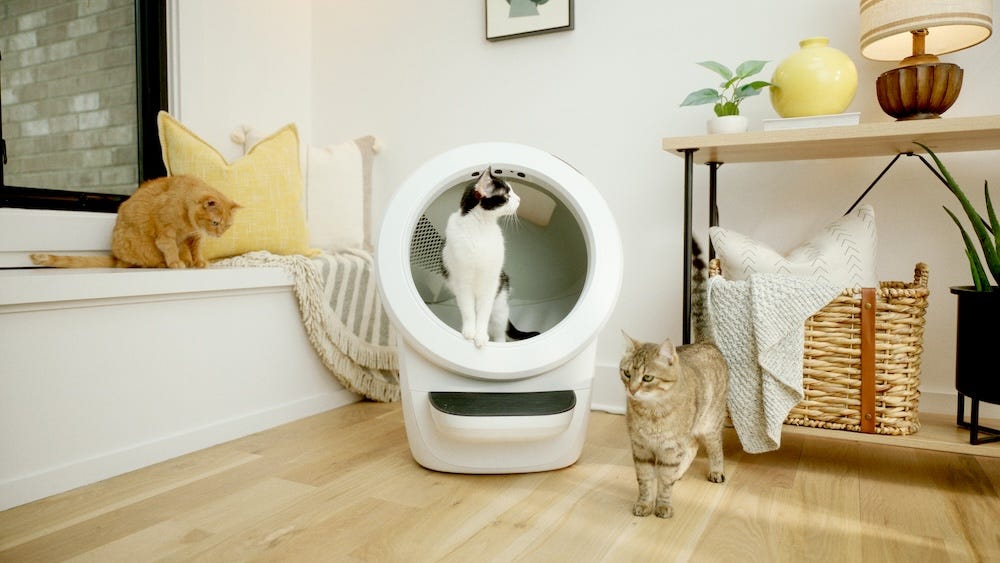
Before you welcome your new cat into your home, make sure to prepare a checklist of all the cat-essentials you will need:
- Cat carrier - This is the number one thing you will need to bring your cat home. A sturdy cat carrier is an essential tool for transporting your cat safely to and from the veterinarian, groomer, or other destinations.
- Cat food - Choose a high-quality cat food that meets your cat's nutritional needs based on their age, activity level, and any dietary restrictions or preferences. Consider both wet and dry food options for variety and hydration.
- Litter box - A litter box is essential for providing your cat with a designated area to eliminate waste. Choose a litter box that is large enough for your cat to comfortably turn around in. You may even consider self-cleaning litter boxes for the added convenience of never having to scoop your cat's poop. Some, like Litter-Robot 4, also offer smart insights about your cat's health.
- Cat litter - According to studies, cats prefer clay-clumping litter over silica or wood pellets, as well as unscented litter. Choose a premium, fast-clumping litter for the best odor control results.
- Bed or blankets - Cats enjoy having cozy spots to rest and sleep. Provide your cat with a comfortable bed, blanket, or cushion in a quiet area of your home where they can relax undisturbed. A memory foam cat bed is among the most comfortable for your new pet.
- Collar - While optional, use a breakaway collar that is fitted properly to your cat and includes important information in case your cat ever gets lost: your cat's name, your phone number, and your address if it fits.
- Toys - Cat toys are essential for keeping your cat mentally stimulated and physically active, especially for high-energy cat breeds. Provide a variety of toys such as interactive toys, balls, wand toys, and catnip toys to keep your cat entertained.
7. Welcoming your new cat into your home
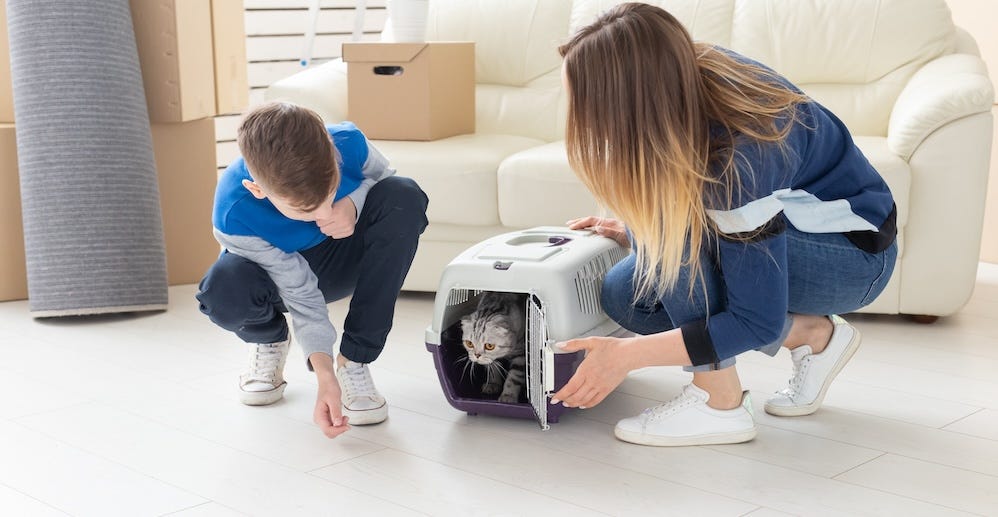
Introducing a new cat to your home
Introducing a new cat to your household can be both exciting for you and stressful for your new cat as they step into unfamiliar territory. Ensuring the comfort and security of your new feline friend, as well as existing pets, is crucial to prevent stress and tension.
- Create a safe space - This is essential to helping your cat acclimate to a new place. Start by keeping your cat in one room, and then slowly let them explore the rest of the house.
- Spend time together - Set some time aside to spend with your new cat. This will help them adjust and feel a greater sense of security.
- Delay introduction to pets or people - Give your new addition time to adjust to their environment before introducing them to small children or other pets.
- Be patient - Your new cat will likely experience some stress when they first arrive, but patience is key. With a new environment, accidents outside the litter box may happen, but don't despair. Your cat will adjust in time.
Introducing a cat to another cat
Regardless of how many feline family members you have, the most important thing is for ALL your cats to get along. If not, you may find yourself dealing with cat fights, spraying, and territorial guarding (of food bowls, litter boxes, toys, and more).
- Create a safe space - Start by keeping your cats in separate areas. Set two home bases and swap scents so your cats get used to each other even without contact. This can be a good strategy if you are introducing a kitten to an older cat as well.
- Go slow - It can take cats several weeks or even months to develop a relationship with each other. The slower, the better.
- Watch out for negative body language - This includes flattening the ears, hissing, growling, and more. You might need to take it slower if any of these signs appear.
Introducing a cat to a dog
Introducing a cat and a dog can be a bit trickier. Don't allow in a face-to-face meeting immediately—at least not without very close supervision.
- Create a safe space for the cat - Find a room with a secure door and windows, a scratching post, and maybe even some cat shelves to allow your cat to have an escape route and feel more secure.
- Familiarize through barriers - Swap scents, rotate rooms, use a baby gate, and take several days or weeks for each pet to get familiar with each other's smells and sounds.
- Make leashed introductions - Make sure the dog is securely leashed but allow the cat to come and go. The goal is to get to a point where your dog is calm around the cat.
- Let them loose together - Once they are comfortable in each other's presence, allow both pets to be in the same room—but keep your dog's leash on in case of sudden aggression.
- Allow unsupervised interactions - Once you’re positive the pets won’t be aggressive with each other, you can allow unsupervised interactions.
Introducing a cat to children
Small children are often less attuned to the acclimation process and can be impatient with your new cat’s need for space. Prepare your children for the cat's arrival and help them understand that the cat will need some time, privacy, and space in order to feel truly at home. You should ensure that your cat has a space to seek refuge. Stop your children from grabbing at the cat and tell them it's best to let the cat come to them instead.
Mistakes to avoid
- Not expecting accidents - This is going to be a big change for both you and your new cat, and that can be very stressful. This might lead your cat to pee next to the litter box at first, to be more on edge, or even aggressive at times. Just remember that everything takes time—especially adjusting to a new home.
- Introducing pets too quickly - Be prepared for a cacophony of hissing, spitting, and growling during the first meeting, especially if you try to rush things.
- Failing to understand the importance of spaying or neutering - Unaltered animals have a much higher risk of certain cancers, tend to roam and get into fights, vocalize, and spray urine.
8. Schedule a veterinary check-up
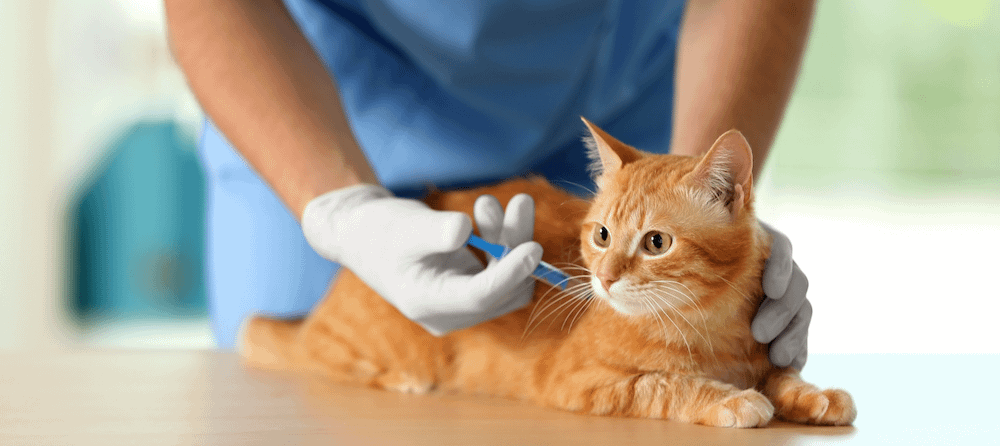
Schedule a veterinary check-up for your new cat soon after bringing them home. This is important to ensure they are healthy and up-to-date on vaccinations, and it allows you to discuss any questions or concerns with your veterinarian.
This is also important if your cat is chipped. You need to ensure the vet will have up-to-date information about your cat's new owner.
If you adopted your cat from a shelter, there is a good chance they are already vaccinated, chipped, and spayed or neutered. However, that's not necessarily the case for stray cats or even if you adopted your cat from a breeder.
The recommended vaccines for cats are:
- Feline panleukopenia virus
- Feline viral rhinotracheitis, also known as herpes virus type 1 (FHV-1)
- Feline caliciviruses
- Rabies virus
- Feline leukemia virus (FeLV)
When you’re not ready to adopt
Adopting any pet shouldn’t be taken lightly. We all want our pets to live forever, and many cats are extending their lives to 20 years or more. Luckily, there are other ways to enjoy the company of a cat or kitten without the commitment.
How to foster cats and volunteer
It’s not just the snuggle of a cat in need that makes you feel all warm and fuzzy when you foster—you’re doing the hard work of socializing cats, providing an environment to heal from an injury or sickness, and making room in shelters for other cats in need.
Wondering if you can foster if you have resident cats at home? Absolutely— esident cats play an important role in teaching healthy and vaccinated fosters how to socialize.
“Volunteers are critical to most shelters and rescues,” Bays says. “Some volunteer roles may involve hands-on interaction with cats. Others may be focused on interacting with people, such as outreach and events.” If you’re interested in fostering or volunteering, contact your local shelter—they’ll be glad to hear from you.
When rehoming a cat is okay
The decision to rehome a cat is never easy, although it may sometimes be the right thing to do—but you should first assess whether the problem can be changed and if there are any alternatives.
If finances are a problem, you may want to look into local organizations that can supply free food to low-income pet parents. If the problem is behavioral, you can try taking advantage of some of the great cat behavior resources out there such as iCatCare. If your situation involves multiple cats, you could consider setting up a time-sharing situation where you divide up your home so each cat gets time with the humans.
If you’ve tried everything and it’s clear that keeping your cat in your home will be more detrimental than finding them a better environment, rehoming may be the next step—but you should rehome a cat the right way.
